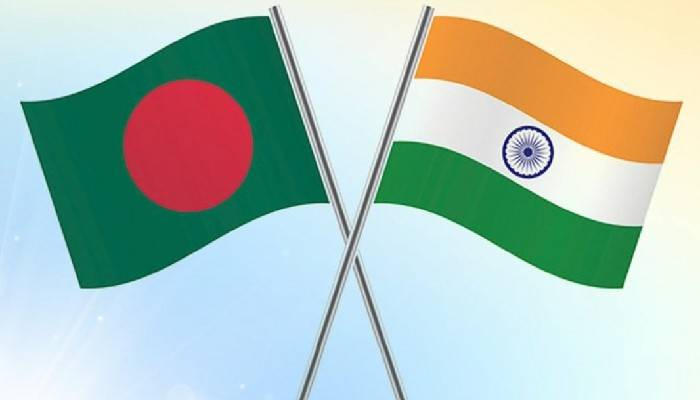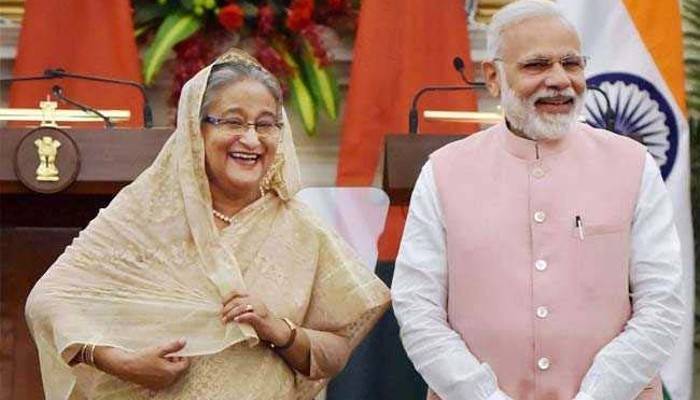
Not only economic ties, but also India’s shared cooperation with Bangladesh in the areas of security, counter-terrorism, anti-radicalisation, energy, advanced tech, ecology, vaccines would contribute largely in the South Asian regional stability…reports Asian Lite News
India was one of the first countries to establish bilateral diplomatic ties with Bangladesh. With the recognition of independence of Bangladesh on December 6, 1971, this relation was born out of Bangladesh’s liberation struggle against the oppressive force of Pakistan.
The year 2021 marks the glorious 50th anniversary of diplomatic relations between both states which is also the golden jubilee of Bangladesh’s independence from Pakistan.
Bangladesh and India celebrate their tremendous efforts of being ‘trusted friends’ over the years. Both the countries decided to commemorate December 6 as ‘Maitri Diwas’ (Friendship Day) during the visit of Indian Prime Minister Modi on the occasion of golden jubilee of Bangladesh in March 2021. The bilateral partnership has flourished every aspect of cooperation from trade to energy, security to connectivity. The magnitude of friendship and partnership between Bangladesh India over the past decade has contributed to a paradigm shift in their bilateral relations. Many analysts term the relationship as a model for other countries in South Asia and beyond.
Bangladesh and India share a 4,096 km-long international border, the fifth-longest land border in the world, being the neighbouring state and the liberation wartime ally, Bangladesh considers bond with India is inscribed in blood, which is hard to shake. However, this bond faced strategic changes with the regime change in Bangladesh started from 1975 after the assassination of Father of the Nation, Bangabandhu Sheikh Mujibur Rahman, as the period before that was known as ‘honeymoon period’ (1971-1975) of the relations.
After that, Bangladesh experienced military regimes which ended the honeymoon period. During the period of the Bangladesh Nationalist Party (BNP) in 2001, the relations further took a downturn due to its anti-India posturing. Later, it started to improve when Sheikh Hasina led- Awami League government came to power.

In 2010, Hasina visited New Delhi to build a ‘stable and fruitful relationship’, and both the nations sought to address cross-border terrorism and India’s connectivity with Bangladesh through the northeast region. In a joint communique, the two Prime Ministers shared vision for the future which would include cooperation in water resources, power, transportation, connectivity, tourism, and education. Later on in 2013, a credit line of $800 million was extended by the Manmohan Singh government and ‘Maitreyi express’ was revived between Kolkata and Dhaka that operationalises the bus services in these routes.
In 2017, Sheikh Hasina visited New Delhi and the result was dozens of agreements being signed concerning trade, transport, energy as well as counterterrorism. The bilateral trade of India with Bangladesh steadily improved over the years, as it was about $6 billion in 2015-16 and crossed the landmark $10 billion in 2018-19. Hence, trade relations strengthened between the two nations and Bangladesh is India’s largest trading partner in South Asia with the total bilateral trade between the two nations standing at $9.5 billion in 2019-20.
Not only economic ties, but also India’s shared cooperation with Bangladesh in the areas of security, counter-terrorism, anti-radicalisation, energy, advanced tech, ecology, vaccines would contribute largely in the South Asian regional stability. South Asian region is at cross-roads due to a new geopolitical landscape, looming economic crisis, and security challenges triggered by Afghanistan situation, Pakistan crisis and Sri Lanka crisis. The impact of the Ukraine War, threats of terrorism and radicalization and bilateral conflicts has further caused regional instability in South Asia. In this context, bilateral partnership between Bangladesh and India is critical from a regional perspective.
Undoubtedly, in South Asia, the partnership that exists between Bangladesh and India is an exemplary one. Starting from the trade partnership to security cooperation, both the countries enjoy the support of each other and can negotiate in areas like land boundary, connectivity, trade deficits, water problem and maritime disputes. Bangladesh and India enjoy benefits from bilateral cooperation in a win-win situation in the areas of economy, security, trade, ports, energy, investment, social links, and transit issues.

Economic Cooperation
Both Bangladesh and India consider each other as one of the vital trading partners. India is the second largest trade partner of Bangladesh. Bangladesh’s share in India’s export increased from 1.4 per cent in 2010 to 3.5 per cent in 2021. India’s share in Bangladesh’s goods exports stood at 3.3 per cent. Being part of South Asian Free Trade Area (SAFTA), both the countries get preferential treatments in case of tariff concessions in their respective markets. Bangladesh is by far the largest trading partner for India in South Asia, which portrays the positive economic cooperation that exists between both states. This cooperation is significant in a region like South Asia to deepen mutual understanding that would develop the region gradually as an integrated, secured and self-sufficient unit.
Security Relations
The security and military ties of the two countries were established in 1971 during the glorious days of Liberation War of Bangladesh when India actively provided its military support. The partnership between the two nations pioneered extraordinary level of security cooperation during the Bangabandhu government, 1972-1975 which discontinued with the tragedy of assassination of Bangabandhu on August 15, 1975. The security cooperation revived based on mutual understand during the Sheikh Hasina government first in 1996-2001 and then 2009-present.
In 2015, during Prime Minister Modi’s visit to Bangladesh, both the countries agreed on joint coast guards in view of combating piracy and enhancing maritime security in the Bay of Bengal region.
Hasina and Modi held a dialogue on “regional security and cooperation in combating international terrorism.” Both countries’ higher officials signed a variety of agreement including cyber security, defence, connectivity, energy, and a civil nuclear cooperation.
The signing of memorandum of understanding (MoU) on defence cooperation during the visit of Prime Minister Sheikh Hasina to New Delhi in 2017 is another milestone in security cooperation. These agreements are not only crucial to maintain bilateral peace but also required for maintaining regional stability in South Asia. As Pakistan in the region is more known to support and breed terrorism, terrorist activities, a stronger Bangladesh-India military cooperation would strengthen their security by countering any military or terrorist threats.

Recent Developments in their Relations
In June 2015, Premiers of both countries implemented the long awaited ‘Land Boundary Agreement’ and settled boundary disputes, hence 50,000 people living in the border enclaves received their identity. This agreement was termed ‘historic milestone’. The disputed land areas were source of human trafficking, illicit migration, smuggling, hubs of terrorists, which were overall a threat for regional stability. With the combined efforts of Bangladesh and India, a proper solution was made.
The maritime boundary dispute in the Bay of Bengal between Bangladesh and India were solved in 2014. The resolution of the dispute was a win-win arrangement for both the countries. Bangladesh is also a part of BBIN (Bangladesh, Bhutan, India, Nepal), a sub-regional initiative that is motivated to improve connectivity and economic development among the member states.
Though the regional initiatives in South Asia gained less traction previously, still India proposed this multilateral initiative with the intention of strategic connection and cooperation where Bangladesh plays a significant role. An agreement in the sector of connectivity would ease channels for carrying trade across these states. India’s core foreign policy focus on the ‘Neighbourhood First’ reminds them to connect neighbouring states, Bangladesh-India relation is an example of this and it leverages the entire region as a whole.
The proposed Comprehensive Economic Partnership Agreement (CEPA) between the two nations is one of the agreements that both the countries are prioritizing. In March 2021, two states agreed to enhance trade under this agreement with a need for the removal of non-tariff barriers, need for predictability of trade policies, regulations and procedures. This is mutually beneficial for a rising economy like Bangladesh and a prospering India, which sets a ‘benchmark of relation’ in South Asia, that overall contributes in a stable regional progress.
ALSO READ: Bangladesh extends a helping hand to Lanka


